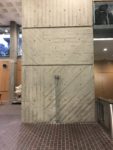The Behavior of Concrete Stripes and Lattices

Harvard’s new Smith Campus Center opened less than a month ago, and ever since then I’ve done most of my studying there. While the main Harvard Commons area is all brand-new wood and glass, the building’s main corridor is dominated by large, exposed concrete walls. While exiting the building one day, I noticed that these walls have a particular and peculiar design to them which consists of parallel lines and rows of holes spaced two feet apart. Below are a few pictures of the concrete that I took last week. These lines are either vertical, horizontal, or measured to be at 45 degrees.
Read More
